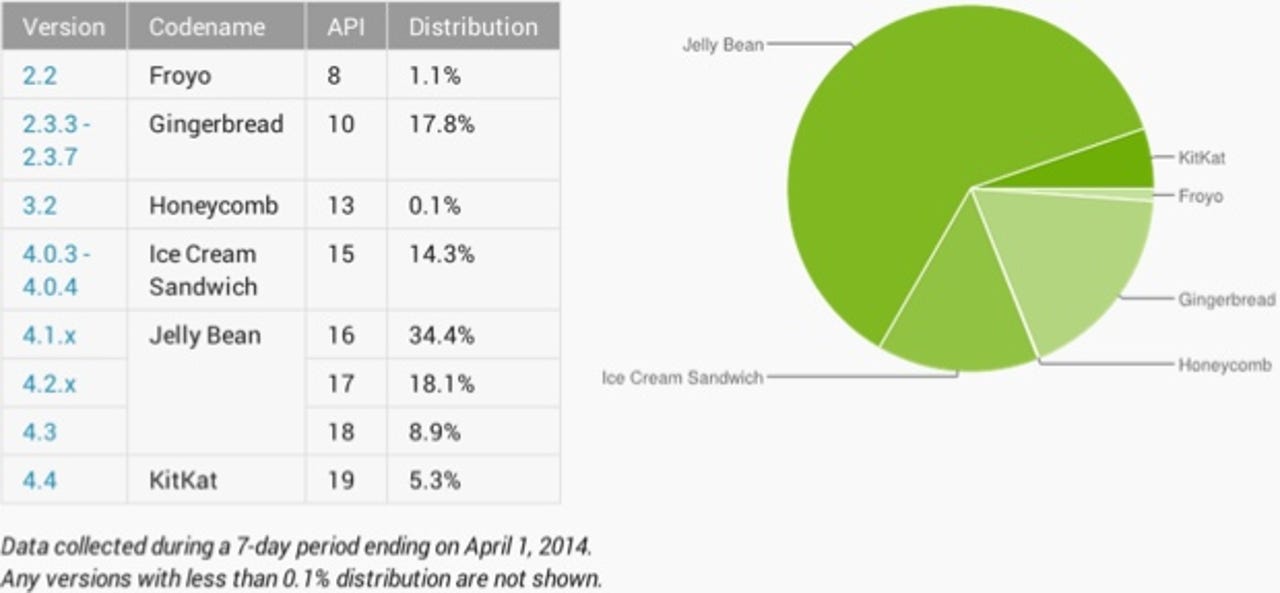KitKat market share doubles in a month, hits 5.3 percent

According to stats published by Google, the newest Android release, codenamed KitKat, is powering one out of every 20 Android devices accessing the Google Play store.
The data, which is based on smartphones and tablets accessing the Google Play store over a 7-day period ending on April 1, 2014, shows that Android 4.4, codenamed KitKat, is installed on 5.3 percent of devices.
This time last month KitKat market share was at 2.5 percent, which means that over the course of the month usage of the new operating system has doubled.

Android 4.4 was release on 31 October, 2013, and first made its public appearance on the Nexus 5, but it now powers a whole range of smartphones and tablets.
See also: Android bugs leave every smartphone and tablet vulnerable to privilege escalation
This latest version has a long way to go to catch up with the previous release, codenamed Jelly Bean. This release, which includes versions 4.1.x, 4.2.x and 4.3, power 61.4 percent of Android devices (down 0.6 percentage points since last month) and makes it the single most popular version. However, Android version 4.1.x is the single most popular release, installed on 34.4 percent of devices.
This means that there's considerable fragmentation among devices running Jelly Bean, with the majority unable to benefit from features introduced in versions 4.2.x, 4.3, and now 4.4 as KitKat is rolled out to handsets.
However, Jelly Bean's nearest rival continues to be Android 2.3.x Gingerbread, a version first released back in February 2011, and this version continues to power 17.8 percent of the devices accessing the Google Play store, down one percentage point since last month. However, the good news is that this version's dominance is eroding slowly as the months progress, but it is likely to remain significant until well into 2015.
The problem with getting users up to the latest version is not down to a lack of interest. Indeed, the speed and ferocity with which iOS users upgrade to the latest version shows that users clearly are interested in new versions of operating systems. The problem is that Google is the beginning of a long system that updates have to go through.
Whenever Google releases a new version of Android, device OEMs have to then customize the release, add their own tweaks and personalizations. Then, for smartphones and tablets that are hooked to a carrier contract, the carriers have to add their own branding. The problem is made worse by the fact that neither the OEMs nor the carriers feel there's much of a benefit in pushing free software updates to customers, and would rather focus on selling owners a new device.
Another problem with such fragmentation and slow pace of updates is that users stuck on older versions of Android are being left vulnerable to malware and data theft as a result of bugs in the code. Take, for example, the recently-discovered Pileup bugs which leaves every Android-powered smartphone and tablet – more than a billion devices in all –vulnerable to malware thanks to privilege escalation issues.
Beginning in April 2013, Google started delivering data collected from each device when the user visited the Google Play Store. Previously, the data was collected when the device simply checked in to Google servers. Google believes that the new data "more accurately reflects those users who are most engaged in the Android and Google Play ecosystem."
See also:
- Why I can live without Office for iPad
- Eight out of 10 businesses believe Macs are more reliable than Windows machines, claims new survey
- Android bugs leave every smartphone and tablet vulnerable to privilege escalation
- Apple iBeacons: With great power comes great potential to annoy
- Poor battery life after installing iOS 7.1? Try these simple tips
- iOS 7.1 grabs 21 percent usage share in 3 days